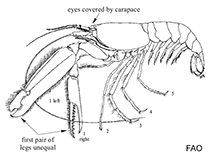Potamalpheops tyrymembe Soledade, Santos & Almeida, 2014
تصوير گوگل | No image available for this species;
drawing shows typical species in Alpheidae.
رده بندی / Names اسامي عام | مترادف | CoL | ITIS | WoRMS
Malacostraca | Decapoda | Alpheidae
Environment: milieu / climate zone / تغييرات عمق / distribution range بوم شناسي
; لب شور; تغييرات عمق 1 - 3 m (مرجع 129123). Tropical
Distribution كشورها | مناطق سازمان خوار و بار جهاني (FAO) | Ecosystems | ظهور | معرفي
Southwest Atlantic: Brazil.
Length at first maturity / Size / Weight / سن
بلوغ: Lm ? range ? - ? cm Max length : 0.4 cm CL جنس نر / بدون خواص جنسي; (مرجع 129123)
توصيف مختصر ريخت شناسي
Life cycle and mating behavior بلوغ | تولید مثل | تخم ریزی | Eggs | Fecundity | Larvae
مآخذ اصلی
مراجع | هماهنگ كننده | همكاران
Soledade, G.O., P.S. Santos and A.O. Almeida 2014 Potamalpheops tyrymembe sp. n.: the first southwestern Atlantic species of the shrimp genus Potamalpheops Powell, 1979 (Caridea: Alpheidae). Zootaxa 3760(4): 579-586. (مرجع 129123)
وضعيت در فهرست قرمز IUCN
(مرجع 130435: Version 2025-1)
وضعيت از نظر سايتس (مرجع 108899)
CMS (مرجع 116361)
خطر برای انسان ها
استفاده انسانی
| FishSource |
ابزارها
اطلاعات بيشتر
تركيب غذايي
مصرف غذايي
شکارچیان
Max. ages / sizes
Length-weight rel.
Length-length rel.
نوسانات طولی
Mass conversion
فراواني
بلوغ
Fecundity
تخم ریزی
Eggs
نمو تخم
Larvae
منابع اينترنتي
BHL | BOLD Systems | CISTI | DiscoverLife | FAO(Publication : search) | Fishipedia | GenBank (ژنوم, نوکلئوتيد) | GloBI | Gomexsi | Google Books | Google Scholar | Google | PubMed | Tree of Life | Wikipedia (برو, جستجو) | Zoological Record



